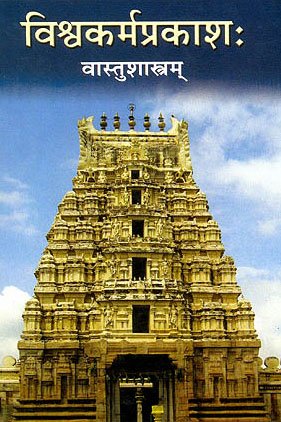Dakshinasha, Dakṣiṇāśā, Dakshina-asha: 7 definitions
Introduction:
Dakshinasha means something in Hinduism, Sanskrit. If you want to know the exact meaning, history, etymology or English translation of this term then check out the descriptions on this page. Add your comment or reference to a book if you want to contribute to this summary article.
The Sanskrit term Dakṣiṇāśā can be transliterated into English as Daksinasa or Dakshinasha, using the IAST transliteration scheme (?).
In Hinduism
Vastushastra (architecture)
Source: Brill: Śaivism and the Tantric Traditions (architecture)Dakṣiṇāśā (दक्षिणाशा) refers to the “right (side)” (of Śiva), according to the Mohacūrottara (verse 4.234-243).—Accordingly, [while describing the construction of the maṭha]—“And a maṭha for ascetics to stay in should be in the south. For they, as devotees of Śiva, should reside to the right [of Śiva] (dakṣiṇāśā—yatas te dakṣiṇāśāyāṃ). One should build a wall at a distance 1 temple-width beyond the temple base. At a distance from there is the housing for ascetics. [...]”.

Vastushastra (वास्तुशास्त्र, vāstuśāstra) refers to the ancient Indian science (shastra) of architecture (vastu), dealing with topics such architecture, sculpture, town-building, fort building and various other constructions. Vastu also deals with the philosophy of the architectural relation with the cosmic universe.
Shaktism (Shakta philosophy)
Source: Google Books: ManthanabhairavatantramDakṣiṇāśā (दक्षिणाशा) refers to the “western quarter” [?], according to the Ṣaṭsāhasrasaṃhitā, an expansion of the Kubjikāmatatantra: the earliest popular and most authoritative Tantra of the Kubjikā cult.—Accordingly, “The Face of the Unborn, free of defects, is the penetration of the energy of the will. Conjoined with the energy of knowledge (the face of) Īśāna is located above. It is said that the eastern face of the goddess is Tatpuruṣa. Aghora is the face that abides permanently in the western quarter (dakṣiṇāśā-sthita) . O lord of the gods, one should worship the face of Vāma located in the northern quarter. The face called Sadyojāta should be worshipped in the western quarter. The face of Picu is that of Śakti and faces downwards”.

Shakta (शाक्त, śākta) or Shaktism (śāktism) represents a tradition of Hinduism where the Goddess (Devi) is revered and worshipped. Shakta literature includes a range of scriptures, including various Agamas and Tantras, although its roots may be traced back to the Vedas.
Languages of India and abroad
Sanskrit dictionary
Source: DDSA: The practical Sanskrit-English dictionaryDakṣiṇāśā (दक्षिणाशा).—the south. °पतिः (patiḥ)
1) an epithet of Yama.
2) the planet Mars.
Dakṣiṇāśā is a Sanskrit compound consisting of the terms dakṣiṇa and āśā (आशा).
Source: Cologne Digital Sanskrit Dictionaries: Shabda-Sagara Sanskrit-English DictionaryDakṣiṇāśā (दक्षिणाशा).—f.
(-śā) The south. E. dakṣiṇa, and āśā quarter.
Source: Cologne Digital Sanskrit Dictionaries: Monier-Williams Sanskrit-English DictionaryDakṣiṇāśā (दक्षिणाशा):—[from dakṣiṇa > dakṣ] f. ‘southern quarter’
Source: Cologne Digital Sanskrit Dictionaries: Yates Sanskrit-English DictionaryDakṣiṇāśā (दक्षिणाशा):—[dakṣiṇā+śā] (śā) 1. f. South.
[Sanskrit to German]
Sanskrit, also spelled संस्कृतम् (saṃskṛtam), is an ancient language of India commonly seen as the grandmother of the Indo-European language family (even English!). Closely allied with Prakrit and Pali, Sanskrit is more exhaustive in both grammar and terms and has the most extensive collection of literature in the world, greatly surpassing its sister-languages Greek and Latin.
See also (Relevant definitions)
Partial matches: Dakshina, Asha, Aca.
Starts with: Dakshinashala, Dakshinashapati, Dakshinasharati.
Full-text: Dakshinashapati, Dakshinasharati, Dandayama.
Relevant text
Search found 1 books and stories containing Dakshinasha, Dakṣiṇāśā, Dakshina-asha, Dakṣiṇa-āśā, Daksinasa, Daksina-asa; (plurals include: Dakshinashas, Dakṣiṇāśās, ashas, āśās, Daksinasas, asas). You can also click to the full overview containing English textual excerpts. Below are direct links for the most relevant articles:
Garga Samhita (English) (by Danavir Goswami)
Verse 5.7.3 < [Chapter 7 - The Killing of Kuvalayāpīḍa]